Horse chestnut, planting guide and care work
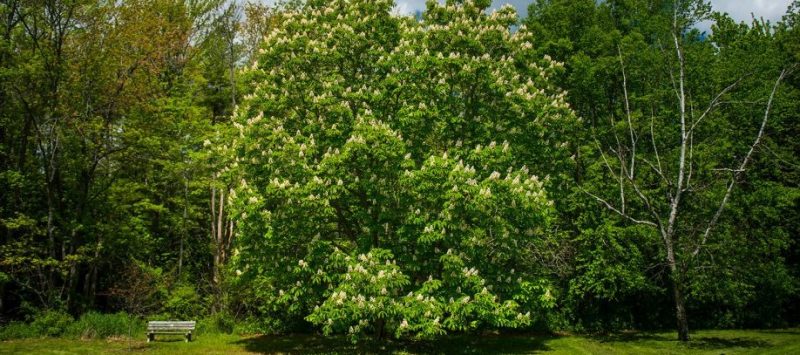
Aesculus ( Horse chestnut) is a genus that includes about 24 species of trees and shrubs in the family Sapindaceae, native to Europe, Asia, and North America. They can grow up to 30 m in height and form a thick, globular crown. They are trees with vigorous growth, especially after 2-3 years, and have a longevity of about 150 years. They have a special decorative value, being grown in parks, gardens, as solitary specimens, in groups or alignments. They can be planted on the edge of the streets, but in unpaved areas, because the roots can damage the pavement.
Species and hybrids
Aesculus hippocastanum (buckeye, European horse-chestnut)
It is a size II-I tree, which can grow up to a height of 25 m. It has a straight trunk, with exfoliating rhytidoma and a globular, wide crown. It has curved branches and thick shoots, with gummy buds. The leaves are large, palmately compound (5-7 leaflets) and have a long petiole. The flowers appear in May-June, are grouped in panicles, which are 20-30 cm long and colored in white, with red areas. The fruits are dehiscent capsules, green in color, with a surface covered with thorns. Inside, there are 1-3 glossy brown seeds, which fall when they reach maturity. Cultivars:
- ‘Plena’ – the flowers are double, sterile.
- ‘Pyramidalis’ – with pyramidal crown.
- ‘Pendula’ – the branches are pendant.
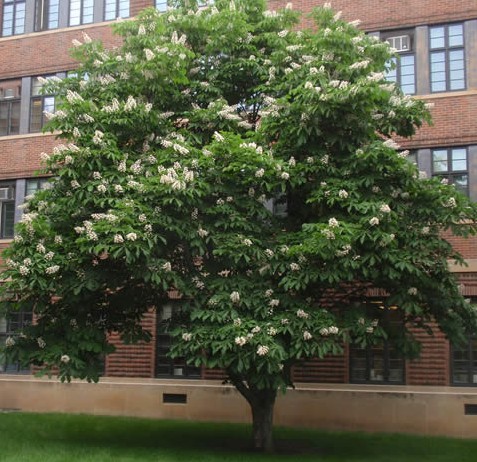
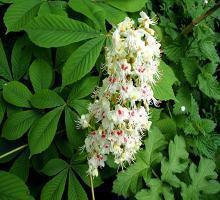
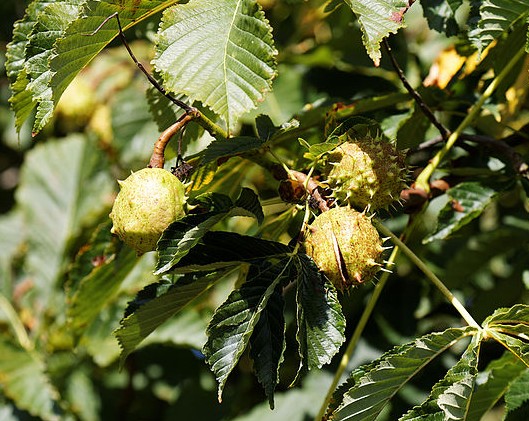
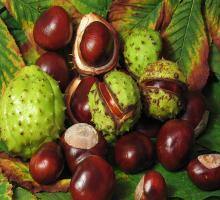
Aesculus pavia (red buckeye)
It is a species with the aspect of a shrub, with a maximum height of 6 m and gummy buds. The leaves are palmately compound, consisting of 5 elliptical leaflets with a serrated edge. The flowers appear in summer and are clustered in 16 cm long panicles, colored in light red.
Aesculus x carnea (red horse-chestnut)
It is a hybrid obtained from the species A. hippocastanum and A. pavia. Its general appearance is similar to that of the buckeye, but it has a smaller height (maximum 20 m). It has pubescent, gray tendrils, and gummy buds. The leaves are palmately compound, consisting of 5-7 leaflets. It blooms in late spring, the flowers grow in small panicles (15-20 cm) and are dark pink. Cultivars:
- ‘Briotii’ – very large inflorescences and flowers colored in intense red.
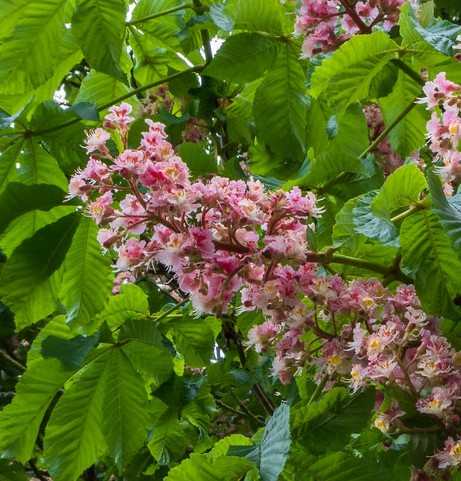
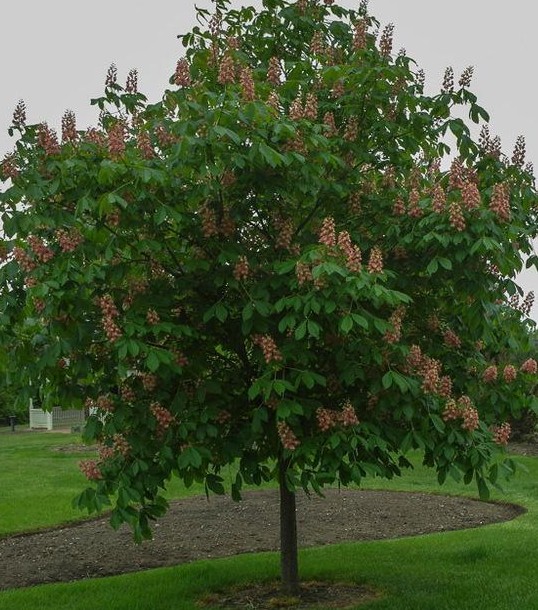
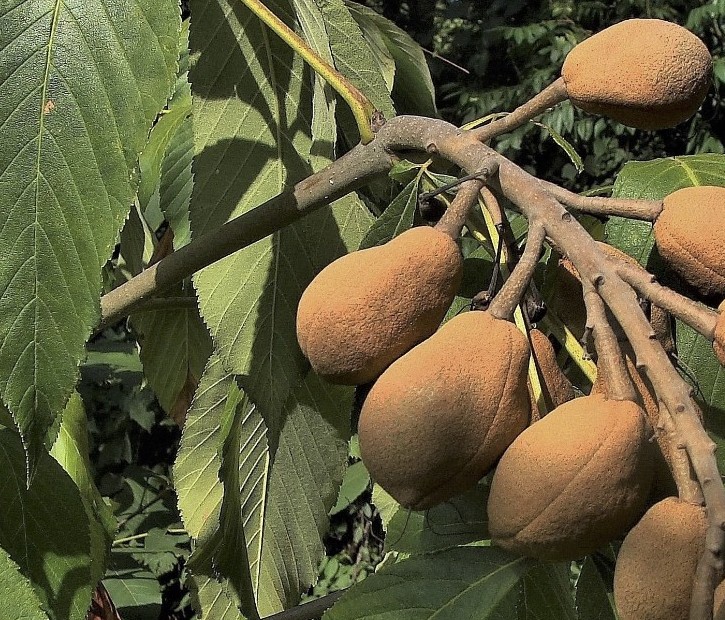
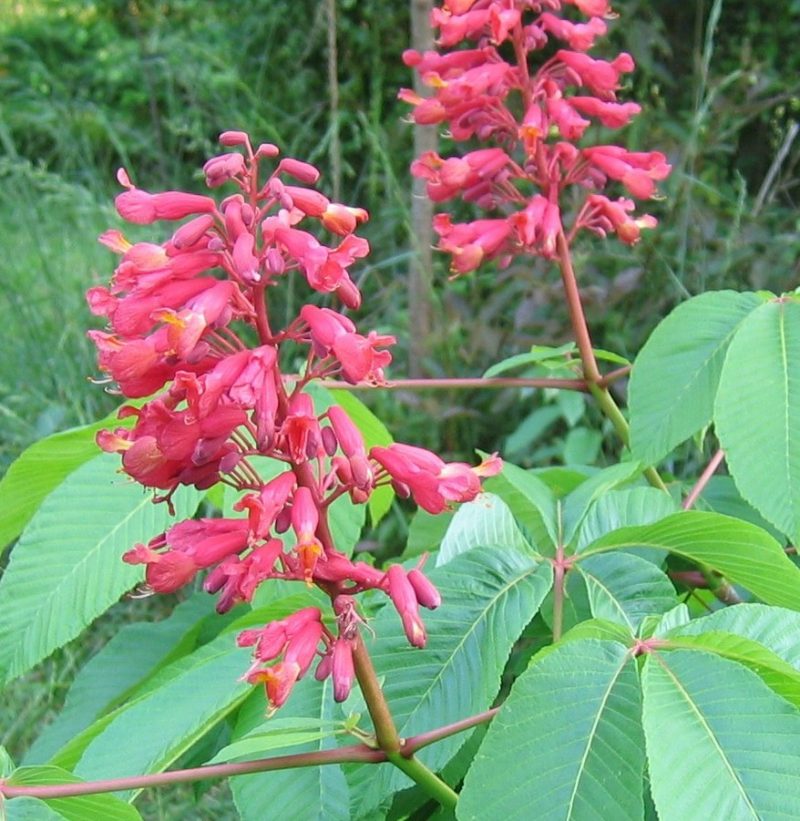
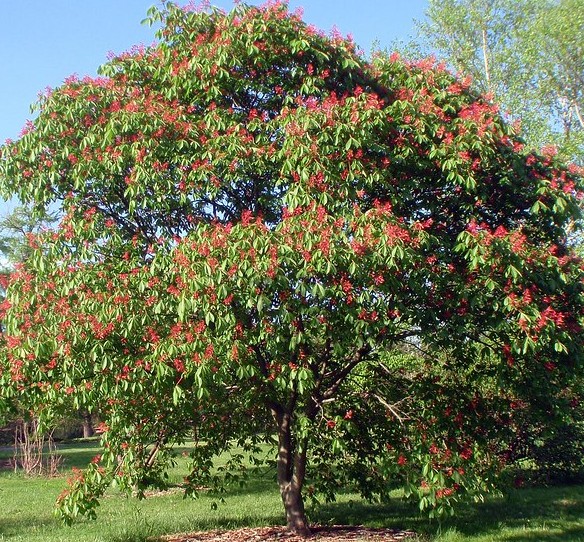
Aesculus octandra (yellow buckeye)
It is a tall tree, with a height of up to 22 m. The leaves are made up of 5 narrow, elliptical leaflets, dark green on the topside and light green on the underside. It blooms in spring-summer, the flowers have green-yellow petals and a pink calyx. The fruit does not have thorns.
Aesculus parviflora (bottlebrush buckeye)
A shrub species up to 4 m tall, weakly branched with gummy buds. The leaves are palmately compound, made up of 5-7 oblong leaflets, 20 cm long, with a sharp tip. The flowers appear in summer, are arranged in 30 cm long panicles, are white with red anthers.
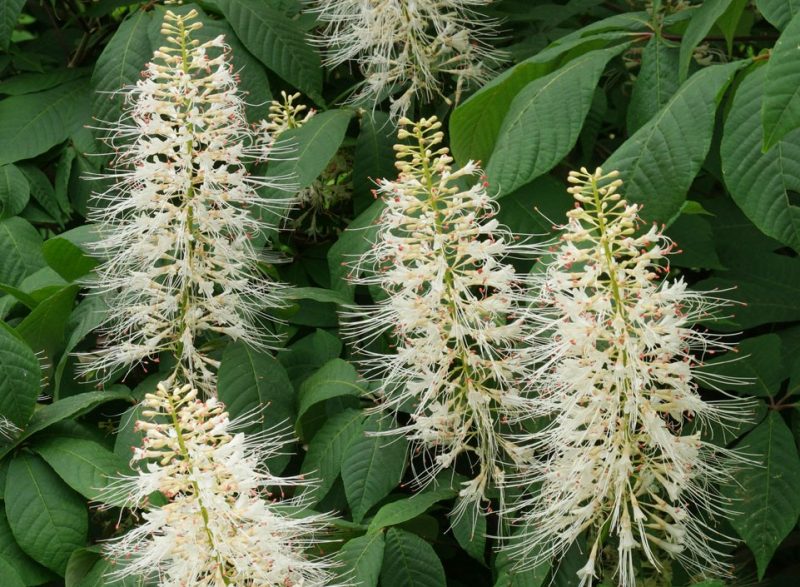
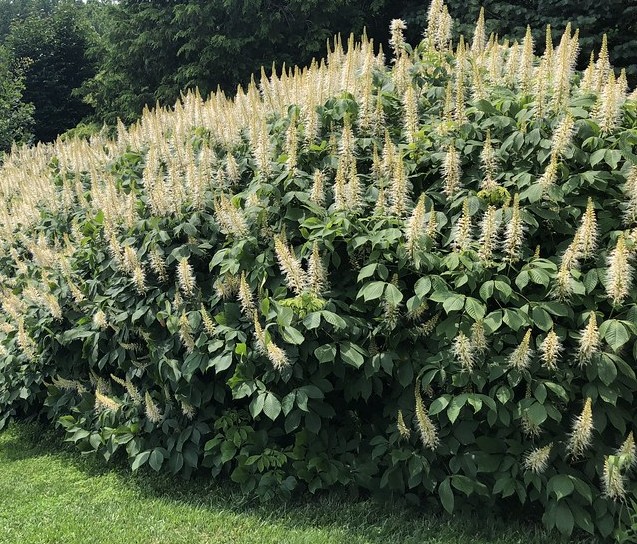
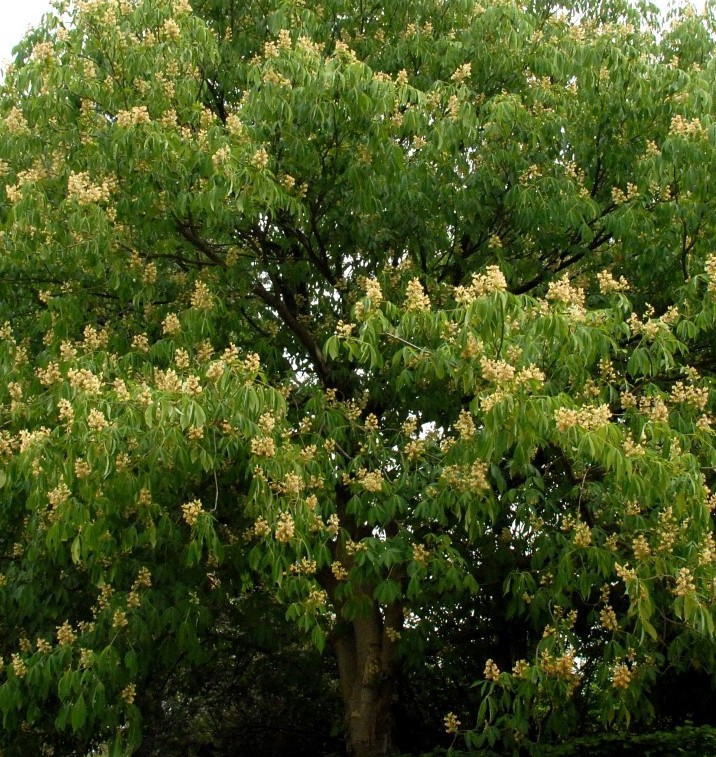
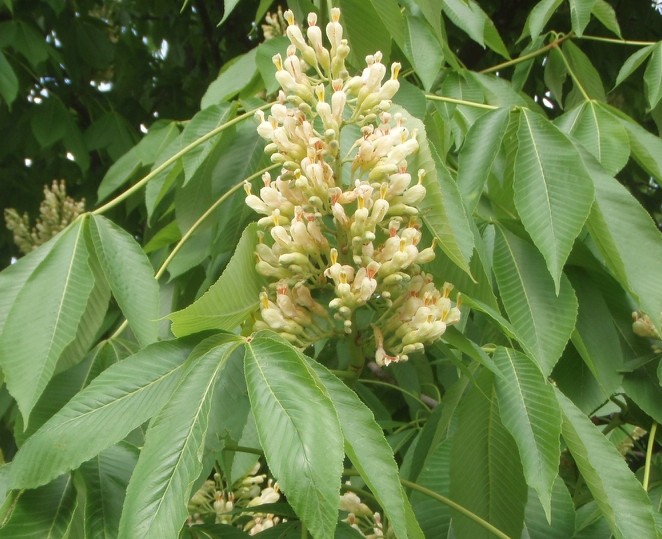
Enviromental conditions
Light. Chestnuts grow optimally in partially shaded areas.
Temperature. Chestnuts are trees that grow in lower mountain areas and are not affected by frost. However, young specimens up to two years old are sensitive to frost.
Soil. They need fertile, light, deep soils. They do not tolerate drought, so the soil must be kept permanently damp.
Fertilization
To stimulate the rich growth of the trees and shrubs, during the vegetative growth period, it is recommended to apply specific fertilizers.
Recommended products
-
You can find products on a different store
Change Store -
You can find products on a different store
Change Store -
You can find products on a different store
Change Store -
You can find products on a different store
Change Store -
You can find products on a different store
Change Store -
You can find products on a different store
Change Store -
You can find products on a different store
Change Store -
You can find products on a different store
Change Store -
You can find products on a different store
Change Store -
You can find products on a different store
Change Store -
You can find products on a different store
Change Store -
You can find products on a different store
Change Store -
You can find products on a different store
Change Store -
You can find products on a different store
Change Store -
You can find products on a different store
Change Store -
You can find products on a different store
Change Store -
You can find products on a different store
Change Store -
You can find products on a different store
Change Store -
You can find products on a different store
Change Store -
You can find products on a different store
Change Store -
You can find products on a different store
Change Store -
You can find products on a different store
Change Store -
You can find products on a different store
Change Store -
You can find products on a different store
Change Store
Pruning
It withstands pruning very well. Thus, cuts can be done annually to correct the shape, during the vegetative dormancy period (in late winter or early spring).
Recommended products
-
You can find products on a different store
Change Store -
You can find products on a different store
Change Store -
You can find products on a different store
Change Store -
You can find products on a different store
Change Store -
You can find products on a different store
Change Store -
You can find products on a different store
Change Store -
You can find products on a different store
Change Store -
You can find products on a different store
Change Store -
You can find products on a different store
Change Store -
You can find products on a different store
Change Store -
You can find products on a different store
Change Store -
You can find products on a different store
Change Store -
You can find products on a different store
Change Store -
You can find products on a different store
Change Store -
You can find products on a different store
Change Store -
You can find products on a different store
Change Store -
You can find products on a different store
Change Store -
You can find products on a different store
Change Store -
You can find products on a different store
Change Store -
You can find products on a different store
Change Store -
You can find products on a different store
Change Store -
You can find products on a different store
Change Store -
You can find products on a different store
Change Store -
You can find products on a different store
Change Store
Recommended products
-
You can find products on a different store
Change Store -
You can find products on a different store
Change Store -
You can find products on a different store
Change Store -
You can find products on a different store
Change Store -
You can find products on a different store
Change Store -
You can find products on a different store
Change Store -
You can find products on a different store
Change Store -
You can find products on a different store
Change Store -
You can find products on a different store
Change Store -
You can find products on a different store
Change Store -
You can find products on a different store
Change Store -
You can find products on a different store
Change Store -
You can find products on a different store
Change Store -
You can find products on a different store
Change Store -
You can find products on a different store
Change Store -
You can find products on a different store
Change Store -
You can find products on a different store
Change Store -
You can find products on a different store
Change Store -
You can find products on a different store
Change Store -
You can find products on a different store
Change Store -
You can find products on a different store
Change Store -
You can find products on a different store
Change Store -
You can find products on a different store
Change Store -
You can find products on a different store
Change Store
Planting
Planting should be done in spring or autumn, during the vegetative dormancy period, at temperatures above 5° C, if the soil is not frozen and there is no danger of frost. Be sure to purchase planting material from authorized nurseries. Immediately after planting, water abundantly, then keep the soil always moist.
Recommended products
-
You can find products on a different store
Change Store -
You can find products on a different store
Change Store -
You can find products on a different store
Change Store -
You can find products on a different store
Change Store -
You can find products on a different store
Change Store -
You can find products on a different store
Change Store -
You can find products on a different store
Change Store -
You can find products on a different store
Change Store -
You can find products on a different store
Change Store -
You can find products on a different store
Change Store -
You can find products on a different store
Change Store -
You can find products on a different store
Change Store -
You can find products on a different store
Change Store -
You can find products on a different store
Change Store -
You can find products on a different store
Change Store -
You can find products on a different store
Change Store -
You can find products on a different store
Change Store -
You can find products on a different store
Change Store -
You can find products on a different store
Change Store -
You can find products on a different store
Change Store -
You can find products on a different store
Change Store -
You can find products on a different store
Change Store -
You can find products on a different store
Change Store -
You can find products on a different store
Change Store
Propagation
Ornamental chestnuts can be propagated through seeds or grafting.
- the seeds must be sown immediately after ripening, with the white part upwards. The resulting seedlings should be kept in place for 2 years.
- grafting can be done through splitting, only in hybrid chestnuts.
Recommended products
-
You can find products on a different store
Change Store -
You can find products on a different store
Change Store -
You can find products on a different store
Change Store -
You can find products on a different store
Change Store -
You can find products on a different store
Change Store -
You can find products on a different store
Change Store -
You can find products on a different store
Change Store -
You can find products on a different store
Change Store -
You can find products on a different store
Change Store -
You can find products on a different store
Change Store -
You can find products on a different store
Change Store -
You can find products on a different store
Change Store -
You can find products on a different store
Change Store -
You can find products on a different store
Change Store -
You can find products on a different store
Change Store -
You can find products on a different store
Change Store -
You can find products on a different store
Change Store -
You can find products on a different store
Change Store -
You can find products on a different store
Change Store -
You can find products on a different store
Change Store -
You can find products on a different store
Change Store -
You can find products on a different store
Change Store -
You can find products on a different store
Change Store -
You can find products on a different store
Change Store
Diseases and pests
The most common pest that can infest chestnuts is the horse-chestnut leaf miner.
In addition:
- chestnuts planted in urban areas are often affected by the strong heat given off by the asphalt.
- drought and pollution can cause early browning of the leaves.
- chestnuts should not be planted in compact, dry and poor soils.















































































































































































































































































































































































































































